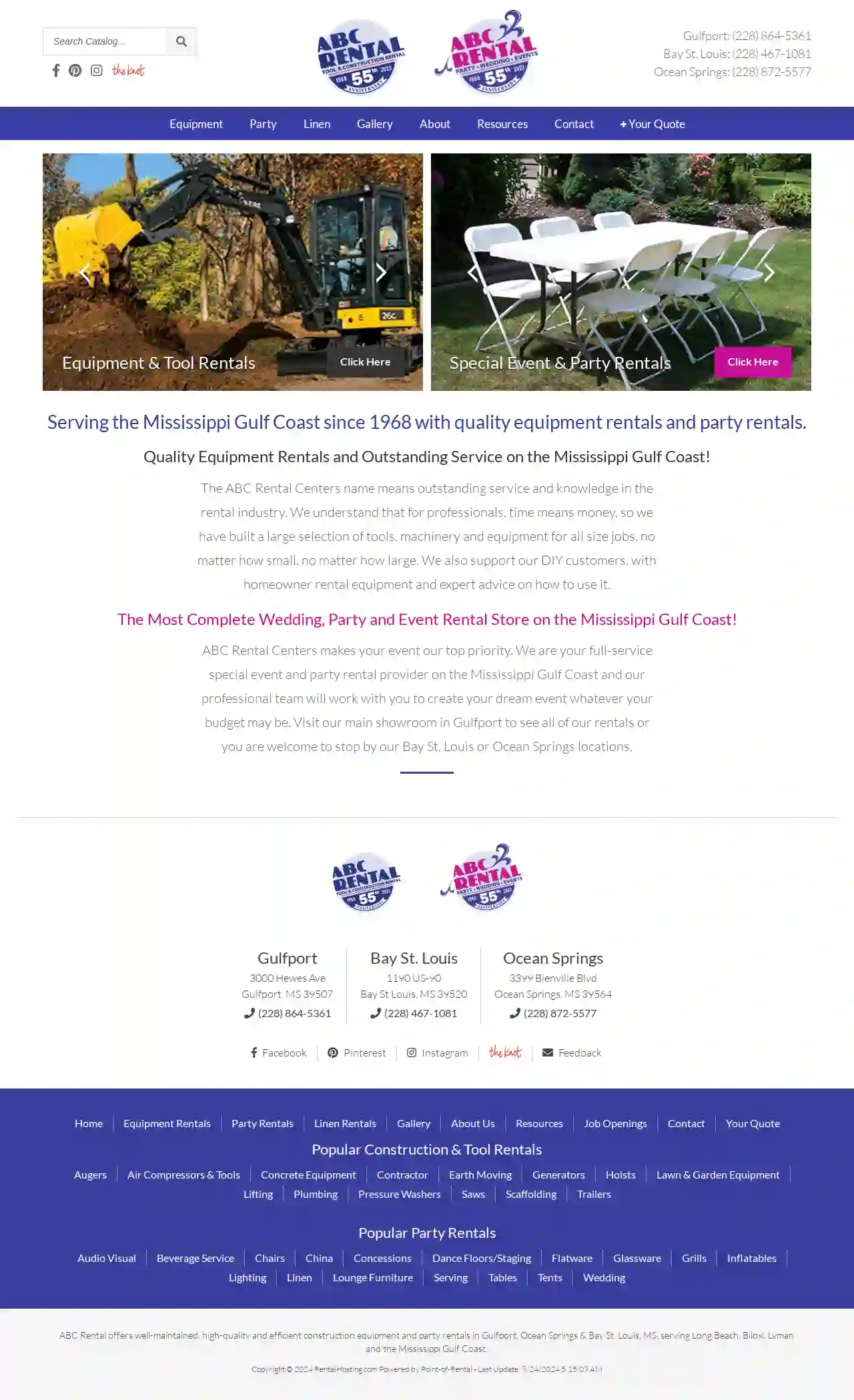Scaffolding Companies Columbia
Top Scaffolding Erectors in Columbia
Get up to 3 Scaffolding Experts quotes for your project today! Compare profiles, reviews, accreditations, portfolio, etc... and choose the best offer.
Service Needed
City or Town

ABC Rental Center
4.4151 reviews3000 Hewes Ave, Gulfport, 39507, USABC Rental offers well-maintained, high-quality and efficient construction equipment and party rentals in Gulfport, Ocean Springs & Bay St. Louis, MS, serving Long Beach, Biloxi, Lyman and the Mississippi Gulf Coast. With a wide range of equipment and party rentals, ABC Rental is dedicated to providing outstanding service and knowledge in the rental industry.
- Services
- Why Us?
- Gallery
Get Quote- Ma
Magnolia Masonry of South Mississippi LLC
4.914 reviewsGulfport, US- Services
- Why Us?
Get Quote - Cr
Crom Equipment Rentals Inc
Gulfport, US- Services
- Why Us?
Get Quote - Lo
Lowe's Home Improvement
4.1Gulfport, US- Services
- Why Us?
Get Quote - Th
The Home Depot
4.2Gulfport, US- Services
- Why Us?
Get Quote
Over 2,353+ Scaffolding Businesses registered
Our scaffolding pros operate in Columbia & surroundings!
ScaffoldingHQ has curated and vetted the Best Scaffolding Businesses in Columbia. Find the most reliable contractor today.
Frequently Asked Questions About Scaffolding Companies
Find answers to common questions about scaffolding companies and hiring scaffolding contractors in the USA.
- Hire Professionals: Just like erection, dismantling should be done by qualified and experienced scaffolding erectors.
- Reverse the Erection Process: The dismantling process should generally follow the reverse order of erection.
- Clear the Area: Ensure the area below is free from people and obstacles.
- Lower Materials Safely: Use ropes or other safe methods to lower dismantled components to the ground.
- Inspect Components: As components are removed, inspect them for damage and store them properly for future use.
- A larger, more complex structure typically used for accessing multiple levels of a building.
- Offers greater height and versatility.
- Often used for construction, renovation, and maintenance.
- Smaller, portable platforms usually used for tasks at a single level.
- Commonly used for painting, plastering, or light repairs.
- Can be rolling or stationary.
- Communicate with the Scaffolding Company: Clearly express your concerns about potential damage to landscaping, structures, or utilities.
- Clear the Area: Remove any valuable or fragile items from the work zone.
- Protect Landscaping: Cover plants, shrubs, and lawns with tarps or protective sheeting.
- Mark Underground Utilities: Ensure underground utilities (water lines, electrical cables) are marked and avoided during installation.
- Supervision: If possible, be present during erection and dismantling to monitor the process.
How do I dismantle scaffolding safely?
Dismantling scaffolding is just as crucial for safety as erection. Follow these guidelines:
What is the difference between scaffolding and staging?
While both provide elevated work platforms, they differ in scale and purpose:
Scaffolding:
Scaffolding:
What is a scaffolding hoist?
A scaffolding hoist is a mechanical device used to lift materials and equipment vertically up and down scaffolding. It's essential for larger projects where manually carrying heavy items up multiple levels is impractical and unsafe. Scaffolding hoists come in various types and capacities, and their selection depends on the weight and size of the materials being lifted.
How do I protect my property from damage during scaffolding erection and dismantling?
To protect your property:
How do I dismantle scaffolding safely?
Dismantling scaffolding is just as crucial for safety as erection. Follow these guidelines:
- Hire Professionals: Just like erection, dismantling should be done by qualified and experienced scaffolding erectors.
- Reverse the Erection Process: The dismantling process should generally follow the reverse order of erection.
- Clear the Area: Ensure the area below is free from people and obstacles.
- Lower Materials Safely: Use ropes or other safe methods to lower dismantled components to the ground.
- Inspect Components: As components are removed, inspect them for damage and store them properly for future use.
What is the difference between scaffolding and staging?
While both provide elevated work platforms, they differ in scale and purpose:
Scaffolding:
Scaffolding:
- A larger, more complex structure typically used for accessing multiple levels of a building.
- Offers greater height and versatility.
- Often used for construction, renovation, and maintenance.
- Smaller, portable platforms usually used for tasks at a single level.
- Commonly used for painting, plastering, or light repairs.
- Can be rolling or stationary.
What is a scaffolding hoist?
A scaffolding hoist is a mechanical device used to lift materials and equipment vertically up and down scaffolding. It's essential for larger projects where manually carrying heavy items up multiple levels is impractical and unsafe. Scaffolding hoists come in various types and capacities, and their selection depends on the weight and size of the materials being lifted.
How do I protect my property from damage during scaffolding erection and dismantling?
To protect your property:
- Communicate with the Scaffolding Company: Clearly express your concerns about potential damage to landscaping, structures, or utilities.
- Clear the Area: Remove any valuable or fragile items from the work zone.
- Protect Landscaping: Cover plants, shrubs, and lawns with tarps or protective sheeting.
- Mark Underground Utilities: Ensure underground utilities (water lines, electrical cables) are marked and avoided during installation.
- Supervision: If possible, be present during erection and dismantling to monitor the process.